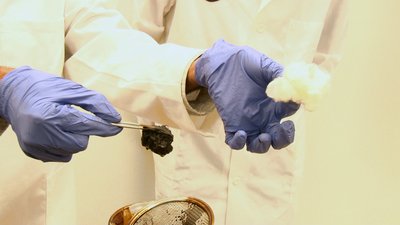Cleaning oil spills with low-grade cotton
When it comes to cleaning up the next massive crude oil spill, an eco-friendly solution for the job may be low-grade cotton from West Texas.
Seshadri Ramkumar, lead author of the study and manager of the Non-wovens and Advanced Materials Laboratory at The Institute of Environmental and Human Health (TIEHH), said he and his colleagues found that low-micronaire cotton - one of the lowest-quality types of cotton - is most effective at picking up oil. A pound of the low-micronaire cotton can pick up more than 30 pounds of crude oil, and its natural waxiness helps to repel water.
The study includes some of the first scientific data on unprocessed raw cotton’s use in crude oil spills and was published in the ACS journal Industrial & Engineering Chemistry Research.

“In this region, about 10% of the cotton grown in West Texas is low micronaire,” he said. “It doesn’t take a dye well, so it gets discounted. However, because low-micronaire cotton is less mature, it shrinks, and you are able to pack more fibre into a given area. The strength here is that the low-micronaire cotton absorbs the most crude oil. The oil is not only stuck to the surface, the oil gets absorbed into the fibre.”
Ron Kendall, director emeritus at TIEHH and special assistant to the president, said the Deepwater Horizon disaster emphasised the need for better ways of cleaning up oil spills.
“One of the things we realised from Deepwater Horizon is we didn’t have the best tools for cleanup, and the technology wasn’t right for the booms,” Kendall said. “This discovery that low-micronaire cotton, which is the least valuable cotton, can absorb as much crude oil as it does is a breakthrough discovery. It gives us an excellent tool for cleanup of shorelines, animals and ecologically sensitive areas as well as a new technology for booms that can stop oil sheen moving into wetlands. And it’s biodegradable. This is just another added bonus use for low-end West Texas cotton. Now, farmers have a new use for low-end cotton in a very significant way for oil spill cleanup. It’s a major discovery from scientific and economic standpoints.”
Scientists have done extensive studies on fibres such as barley straw, kapok, polypropylene wool, Ramkumar said. However, big gaps existed in knowledge about their basic crude oil-uptake mechanisms and no data existed on unprocessed raw cotton. His team decided to fill those gaps with research on the oil sorption properties of low-micronaire cotton.
The cotton fibres take up oil in multiple ways, including both absorption and adsorption in which oil sticks to the outer surface of the cotton fibre.
“Our interest was to see how raw cotton straight from the bale picks up the crude oil as well as determining the governing mechanism behind picking up the crude oil,” he said. “We show through sophisticated testing that low-micronaire cotton is much finer and can pick up more crude oil. And crude oil is very different from refined motor oil. It’s very dense and releases toxic vapours. It’s not as easy to get picked up. In contrast to synthetic sorbents, raw cotton with its high crude oil sorption capacity and positive environmental footprint make it an ecologically friendly sorbent for oil spill cleanups.”
Laboratory work using crude oil was performed by graduate student Vinitkumar Singh. Both Cotton Incorporated and The CH Foundation contributed funds to this research.
Responder washdown system designed for on-scene protection
A portable washdown system aims to provide emergency responders with at-the-scene protection,...
7 reasons to digitise chemical and SDS management
Switching to a digital, cloud-based system for chemical and SDS management can help make safety...
Robot dog can 'sniff' hazardous gases in inaccessible environments
To keep humans out of harm's way, researchers have created a four-legged, dog-like robot that...








